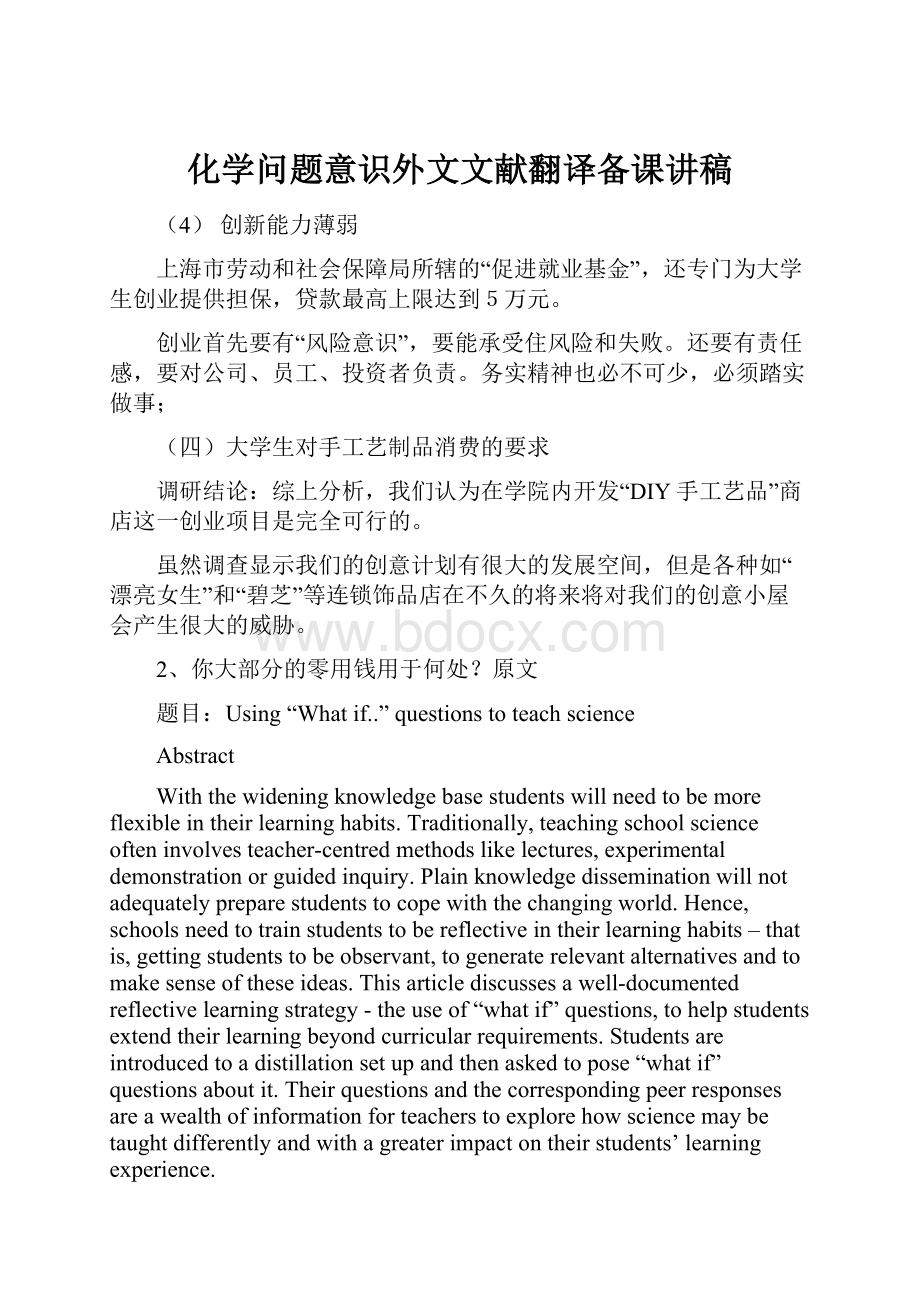化学问题意识外文文献翻译备课讲稿.docx
《化学问题意识外文文献翻译备课讲稿.docx》由会员分享,可在线阅读,更多相关《化学问题意识外文文献翻译备课讲稿.docx(21页珍藏版)》请在冰豆网上搜索。

化学问题意识外文文献翻译备课讲稿
(4)创新能力薄弱
上海市劳动和社会保障局所辖的“促进就业基金”,还专门为大学生创业提供担保,贷款最高上限达到5万元。
创业首先要有“风险意识”,要能承受住风险和失败。
还要有责任感,要对公司、员工、投资者负责。
务实精神也必不可少,必须踏实做事;
(四)大学生对手工艺制品消费的要求
调研结论:
综上分析,我们认为在学院内开发“DIY手工艺品”商店这一创业项目是完全可行的。
虽然调查显示我们的创意计划有很大的发展空间,但是各种如“漂亮女生”和“碧芝”等连锁饰品店在不久的将来将对我们的创意小屋会产生很大的威胁。
2、你大部分的零用钱用于何处?
原文
题目:
Using“Whatif..”questionstoteachscience
Abstract
Withthewideningknowledgebasestudentswillneedtobemoreflexibleintheirlearninghabits.Traditionally,teachingschoolscienceofteninvolvesteacher-centredmethodslikelectures,experimentaldemonstrationorguidedinquiry.Plainknowledgedisseminationwillnotadequatelypreparestudentstocopewiththechangingworld.Hence,schoolsneedtotrainstudentstobereflectiveintheirlearninghabits–thatis,gettingstudentstobeobservant,togeneraterelevantalternativesandtomakesenseoftheseideas.Thisarticlediscussesawell-documentedreflectivelearningstrategy-theuseof“whatif”questions,tohelpstudentsextendtheirlearningbeyondcurricularrequirements.Studentsareintroducedtoadistillationsetupandthenaskedtopose“whatif”questionsaboutit.Theirquestionsandthecorrespondingpeerresponsesareawealthofinformationforteacherstoexplorehowsciencemaybetaughtdifferentlyandwithagreaterimpactontheirstudents’learningexperience.
Introduction
Thepresentsciencecurriculumincludesarangeofstudentlearningoutcomescoveringlaboratoryandexperimentalscience(MOE,2007).Researchersandscholarshadarguedthattherolesofexperimentsandpracticalworkinschoolsshouldallowstudentstopracticelaboratoryskills,learnthevariousinvestigativeprocessesandacquirefirsthandexperiencesindealingwithmaterialsandlaboratorywares(Boud,DunnandHegarty-Hazel,1986;Doranetal,2002;Hegarty-Hazel,1986;Josephsen,2003;Woolnough,1990).Besidesthesecognitiveandpsychomotorobjectivesofschoollaboratorycourses,therearealsosuggestionsthatlessonsshouldbemademoreattractivethroughmoreintellectuallydemandingcoursesandnewteachingtechniquesthatcanmotivatestudentstolearn(Schmidt,2000).Thispaperdiscussesawell-documentedreflectivelearningstrategy-theuseofquestionsposedbystudentstohelpthemextendtheirlearningbeyondcurricularrequirements(ChinandChia,2004;WalshandSattes,2005).Specifically,itdiscussestheuseof"whatif"questionsposedbystudents(Fogarty,1994).Studentsareintroducedtoadistillationsetupandthenaskedtopose"whatif"questionsaboutit.Theirquestionsandthecorrespondingpeerresponsesprovideteacherswithagoodinsightonhowstudentscontributetoknowledgebuildingthroughself-createdlearningopportunities.Theentireexperiencemayalsohelptocreateaclassroomteaching-learningcultureinwhichtheteachertakesontheroleoftheadvancedlearneramongnovicelearners.
Conductingthelesson
Traditionallyalessononexperimentalsciencewouldcommencewithteachertalk,studentevaluationandthenpossibly,aconfirmatoryexperimentalexperienceinthelaboratory.Inquiry-basedlessonsmaytweakthelessonstructureabit,withtheteacherstartingalearningtaskbyaskingaquestion.Forexample,
“Ifyouarestrandedintheopenseaonasmallboat,howwouldyougoaboutmakingsomefreshwatertodrinkfromtheseawateraroundyou?
(Assumingyouhavetheessentiallaboratorywareswithyou.)”
Theteachermaythenfollowupbyfacilitatingaclassdiscussionandendwiththeteachersummarizingandcontextualizingthediscussiontofitthecurricularrequirements.
MortimerandScott(2003)intheirbook,MakingMeaninginSecondarySchoolScience,suggestedthatstudentsshouldengageinsomeformofdialogicactivityiftheyaretodevelopanunderstandingofasciencetopic.Inthisrespect,classroomtalk,learningandmeaningmakingwouldnotmakestrangebedfellowsbutareessentialfeaturesinthescienceclassroomthatwouldensurestudentsgainsomeimpactfullearningexperiences.
Thelesson,whichthepresentdiscussionisbasedon,involvedboththetraditionalclassroomlessondeliveryandtheengagementofstudentdialogicprocess.Itwasconductedforagroupoftensecondarythreeexpressstudents(equivalenttograde8). Thestudents,fourgirlsandsixboys,wereselectedbytheirChemistryteachertoattendaremediallessononthetopicof“SeparationTechniques”.Theycamefromtwodifferentclassestaughtbythesameteacher.Theseparationtechniquetoberevisedinthe40-minutelessonwason“SimpleDistillation”.Theauthorofthispaperwasrequestedbytheirteachertoteachthisremediallesson.Theauthor(referredtoasthe‘remedialteacher’inthispaper)isalsoaqualifiedandexperiencedschoolscienceteacherofover16years.TheproceedingsofthelessonaresummarizedinTable1.
Approximate
Timeframe
Learning/teachingevents
Pedagogicalapproach
10minutes
-Introduction
-Importanceofseparationtechniquesinchemistry
-Exampleofatechnique:
SimpleDistillation
Teachertalk
10minutes
-Activity:
Studentstoposequestions
-Firstattempt:
Invitationtoverbalisethequestions(nostudentsvolunteered)
-Secondattempt:
Invitationtowritedownthequestionsstartingwiththewords“Whatif..”
(Studentswereobservedtobeactivelyontask.)
Reflectivelearningstrategy:
Useof“whatif”questionstogetstudentstoobservethelearningtaskandgenerateresponses(inthiscaseposedquestions)
20minutes
-Activity:
Teacher-facilitatedthediscussiononthewhatifquestionsposedandwritten bythestudentsonslipsofpaper.
-Theslipsofpaperwerecollectedandeachstudent’swrittenquestionswereprojectedonvisualiserandopenlydiscussedbythestudentswithcommentsandevaluativeremarksmadebytheteacher.Studentswereinstructednottowritetheirnamesonthepaper.
Reflectivelearningstrategy:
studentsengagedinmeaningmaking(thatis,attemptingtoanswer,critiqueandperhapsre-phrasethequestionssothatsomerelationshipscanbeestablishedamongtheideasgenerated).
5minutes
-Summary:
teachersummarisedstudents’responsestothelearningtasks
-Conclusion:
teacherconcludedlessonwithareviewofthedistillationmethod
Teachertalk
Table1:
LessonProceedings
Aftertheformalgreetingsandasimpleself-introduction,theremedialteacherproceededtoexplaintheimportanceofseparationtechniquesinchemistry.Hecitedsimpledistillationasanimportanttechniquethatallowsustoobtainapuresolventorliquidfromacontaminatedliquidsample(asolutionorasuspension).Afullylabelleddiagramoftheapparatussetupforsimpledistillationwasprojectedonthescreenwiththehelpofavisualiser(Figure1).Referringtothediagramonthescreen,theremedialteacherthenproceededtoexplainhowthesimpledistillationapparatusworks.Thestudentswereattentiveandsomewerebusytakingnotes.Thissegmentofthelessonlastedabouttenminutesandwastotallydeliveredbyteacher-talk.
Figure1.Diagramofasimpledistillationsetupfordistillingseawater.
Atthisjuncture,studentswereinvitedtoverballyaskanyquestionabouttheapparatussetup.Therewasashortpausewithnoresponsefromthestudents.Theremedialteacherthenrequestedthattheypentheirquestionsonblankpiecesofpaper.Again,thereweresome“thoughtful”actions(forexamples,aboyhadhischinproppedbyhishandonthetableandafewgirlsshowedcontortedeyebrows,allpresumablydeepintheirthoughts).Mostofthemstaredblanklyatthediagramprojectedonthescreen.Again,noonewroteanything.
Theremedialteacherthenwrotethefollowingwordsonthewhiteboard–“Whatif…”andinstructedstudentstobeginposingtheirquestionswiththesetwowords.Healsoaddedthattheycouldaskanythingabouttheapparatussetup,includingthematerials,products,reactionconditionsoranythingthatinterestthem,solongasitwassomethingrelatedtothesimpledistillationprocessorapparatussetup.Theycouldaskquestionsthattheyknowtheanswers,orquestionsthattheydonotknowtheanswers.Noexamplesweregiventothestudentsotherthantheseinstructions.
Itwasobservedthatstudentsbegantopentheirthoughts,writingdownthequestionsandraisingtheirheadsperiodicallytorefertothediagramshownonthescreen.Ittookabouttenminutesbeforemostofthembecameexhaustedofideasandafewstartedtocuriouslypeekintotheirneighbours’work.Theremedialteacherthencollectedthepapersandbegantoflashthemonebyoneonthevisualiser.Foreachstudent’squestionspresented,theremedialteacherfacilitatedanalmostspontaneousresponsefromthefloor.Studentswereobservedtobechattywhileafewshowedamusementsattheirpeers’questions.Therewasalivelycontributiontothepossibilitiesraisedbythequestions,includingdifficultandunfamiliarsituationsarisingfromquestionslike“Whatifthereisnocondenserthere?
”and“WhatiftheBunsenburnerwasreplacedbyacandle?
”(Figure2)
Figure2.“Whatif..”questionscansurfaceunfamiliarexperimentalsituations
The“whatif”questionsandpeerresponses
Theactivitygeneratedalistof26questionsfromthetenstudents(Table2).Thesequestionscanbebroadlyclassifiedinto11differenttypesof“Whatif…”questionspertainingtothetopiconsimpledistillationofseawater.
Conditions
BroadQuestionsAsked
Frequency
A
Missingmaterials
1.“Whatiftherewasnoboilingstonesintheflask?
”
6
B
Changeinsetupofapparatus(includingmissingpieces)
2.“Whatifthepositionsofthewaterinletandoutletofthecondenserwereswitched?
2
3“Whatiftherewerenothermometerinthesetup?
”
1
4.“Whatiftherewerenocon